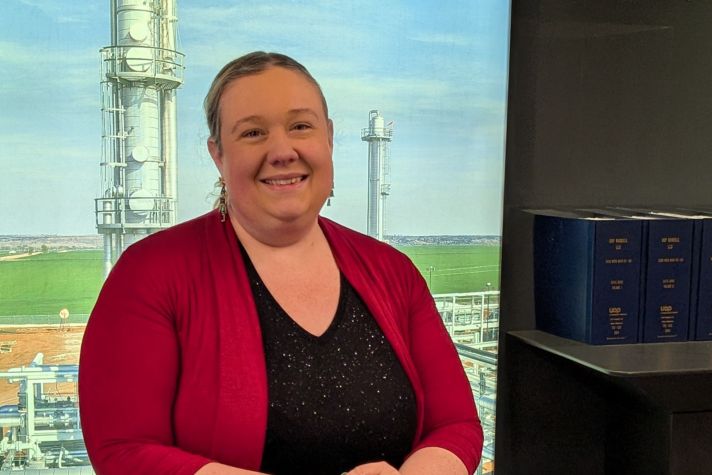Top Innovations of 2021
These breakthrough technologies are game-changers in sustainability, health, travel and beyond.
Advancements in science and technology shaped life in 2021.
As we continue to imagine what the future could look like in a changing world, take a look at the top innovations of the year.
A recycling process to tackle plastics
Plastic waste is filling up our landfills, waterways and rivers – or it’s being incinerated.
But not all plastics can be recycled with the current process, mechanical recycling.
UpCycle, developed by Honeywell UOP, is a new recycling process technology that can reduce the carbon footprint of plastic waste handling typically by more than 50%, compared to conventional incineration and landfilling.
Why it’s innovative: The new advanced or chemical recycling process takes plastic waste that can’t be recycled by current technology and breaks it down to a recycled polymer feedstock (RPF). The feedstock can then be used to manufacture new, high-quality plastics that can be used in food packaging, pharmaceutical products and medical devices, with the goal of enabling a circular plastics economy.
A cockpit that’s connected
A major upgrade for aircraft cockpits is on the horizon.
For pilots and crew, preparing for a flight can take up ample time before takeoff, and a dashboard full of traditional radar and analog displays only give pilots so many ways to look at – and out – of their aircraft.
Our new avionics system, Honeywell Anthem, gives pilots and crews access to the data they need for more efficient takeoffs and smarter flights with digital displays that mimic the quality of smartphone screens.
Why it's innovative: The traditional cockpit is built for commercial aircraft, business jets and rotorcraft (like helicopters). Honeywell Anthem is the first cloud-connected cockpit system designed for those aircraft, as well as low-flying, urban air mobility (UAM) aircraft. It’s already set to be used in Vertical Aerospace’s piloted, zero-emissions electric battery-powered aircraft, and in the six-passenger Lilium Jet, which takes off and lands vertically.
AI to detect methane leaks
Methane is about 80 times more powerful at warming the atmosphere than carbon dioxide over a 20-year period, according to the UN Environment Programme – and leaks from natural gas systems are among the top source of methane emissions caused by human activity, according to the US Environmental Protection Agency.
This year, our gas cloud imaging (GCI) system was launched in Europe to help power plants across the continent achieve automated and continuous monitoring for methane and other natural gas leaks.
Why it’s innovative: Historically, manual methods are used to detect gas leaks – including sending people to detect natural gas leaks when they occur and using handheld equipment to conduct inspections. Now, the use of infrared hyperspectral capabilities – technology that detects invisible gasses like methane – and artificial intelligence (AI), more efficiently detects when and where leaks occur, and which leaks are most dangerous.
Technologies helping drones soar
When powered by batteries and existing technology like line-of-sight radio links, small drones can only fly so long.
Enter our Beyond-Visual-Line-of-Sight (BVLOS) solutions, a set of systems including our hydrogen fuel cells, which operate silently last up to three times longer than batteries; electronically powered multipurpose radar; inertial measurement units (IMU), an array of electronics that informs an aircraft’s system with precise navigation information; and the UAV Satcom – the world’s smallest and lightest satellite communications system that lets pilots view their drone’s cameras and download data.
Why it’s innovative: BVLOS technologies let small drones fly up to three times longer than with existing technologies – and with less human intervention. This can allow small aerial vehicles to carry more, travel farther and fly faster.
A cutting-edge face mask
XUPERMASK, created by will.i.am in partnership with Honeywell, offers a new take on the face mask by marrying form and function. Created with a silicone face seal and an adjustable, ergonomic design.
Why it’s innovative: The first-of-its-kind face mask doubles as a piece of wearable technology equipped with Bluetooth capabilities. Built with dual 3-speed fans and designed to fit HEPA filters, the mask also was designed with noise-cancelling audio and microphone features and LED lights. There’s even a place for wearers to dock their earbuds.
Using quantum computing to protect from cybersecurity threats
This year, the Honeywell System Model H1 became the first quantum computer to pass the Quantum Volume 1024 benchmark, a metric IBM introduced to determine quantum computing capacity.
Now, the trapped-ion quantum computing technology has a new application called Quantum Origin, which can generate strong encryption keys – a string of characters used to secure data – created by Quantinuum, the company formed when our quantum computing business, formerly known as Honeywell Quantum Solutions, merged with Cambridge Quantum.
Why it’s innovative: As our world becomes more connected, cybercriminals are outsmarting current technology meant to protect our devices. Quantum Origin uses quantum mechanics to create random, unpredictable data for encryption keys that are more advanced than what today’s classical computers could produce. Quantum Origin is also a cloud-based platform, so it can be integrated into existing systems used to generate encryption keys.
First passenger flight powered by 100% SAF takes off
On December 1, United Airlines operated the first passenger flight powered by 100% sustainable aviation fuel (SAF).
Why it's innovative: Sustainable aviation fuel (SAF), an alternative to conventional, petroleum-based jet fuel, is helping the aviation industry reduce its carbon footprint. SAF is made by converting already available materials, including mustard seeds, soybeans, non-edible oils and sustainable biomass, into a drop-in replacement crude oil.
SAF can be combined with conventional jet fuel to power aircraft, but United Airlines’ flight in December from Chicago to Washington, DC – which operated using 100% SAF, produced by Honeywell UOP’s EcofiningTM technology, in the right engine – marked a milestone. Soon, more flights will be powered by SAF.
A mass vaccination clinic powered by software
In January, about 5,000 people a day got their first COVID-19 vaccines by attending a mass vaccination clinic held at the Charlotte Motor Speedway.
The effort, which was supported by Honeywell, Atrium Health, Tepper Sports & Entertainment and the State of North Carolina, and backed by North Carolina Gov. Roy Cooper, enabled patients to get inoculated from their parked cars. Existing technologies were put to new use to help manage the flow of thousands of patients each day heading into the venue to get vaccinated.
Why it’s innovative: Barcode technology and QR codes helped both onsite leaders and clinical staff screen patients and document patient information before and during the mass vaccination clinic. Honeywell’s Artificial Intelligence Pro-Watch Software was also used to help leaders monitor queues for the Charlotte Motor Speedway mass vaccination clinic and other mass vaccination events in Charlotte.
World’s most powerful telescope set to make history
The James Webb Telescope – named after the administrator who led NASA in its Apollo era – is the most advanced space telescope built in the history of space, and it’s been in development for more than 30 years.
A partnership between NASA, the Canadian Space Agency and the European Space Agency, the James Webb Space Telescope is planned to launch into space to look further into the universe’s past than any telescope has ever measured. Honeywell’s Aerospace engineers contributed the Fine Guidance Sensor and Near Infrared Imager and Slitless Spectrograph (FGS/NIRISS) technologies to the telescope, which are designed to help Webb point precisely and capture high-quality images in space.
Why it’s innovative: The Webb Telescope’s predecessor, the Hubble Space Telescope, which launched in 1990, could peer 500 million years into the universe’s history. With the Webb Telescope, which is about 100 times stronger than Hubble, scientists can obtain a more detailed look at the cosmos than ever before.
Visibility to air quality risk
The importance of maintaining safe air quality indoors isn’t going away anytime soon. With Transmission Risk Air Monitor, small- to medium-sized indoor spaces like classrooms, restaurants and offices can be monitored for CO2 levels in real-time. This makes it easier to detect conditions that may increase the risk of exposure to airborne viral transmission.
Why it’s innovative: Powered by CO2, temperature and humidity sensors, the risk alert system illuminates in green, yellow and red to alert potential changes in air quality in a mobile app and online dashboard. This means that you don’t have to be present to check in on a room’s air quality.





